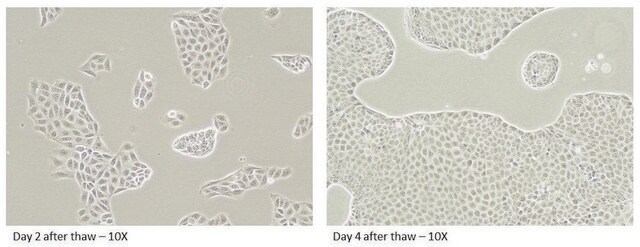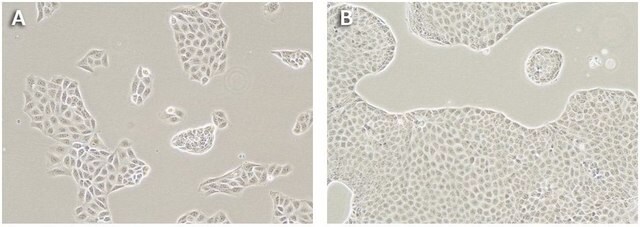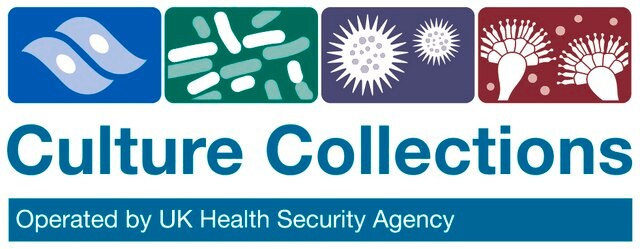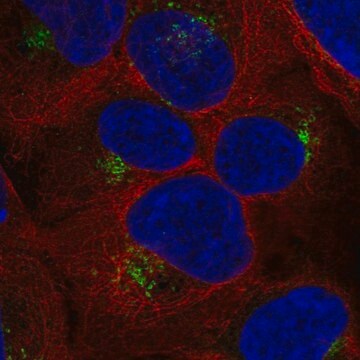MTOX1304Z
MDCKII canine MDR1 KO, human BCRP Expressing Cells
Iniciar sesiónpara Ver la Fijación de precios por contrato y de la organización
About This Item
UNSPSC Code:
12352207
NACRES:
NA.81
Productos recomendados
biological source
canine kidney (cocker spaniel)
usage
sufficient for 1 96-well plate(s) (or 24-well plate)
packaging
vial of 2 million cells
growth mode
adherent
technique(s)
cell culture | mammalian: suitable
drug transporter assay: suitable
application(s)
ADME/TOX
shipped in
dry ice
storage temp.
−196°C
General description
MDCKII - Madin-Darby canine kidney - is a subclone derived from the heterogenous parent line MDCK (ECACC Catalog No. 85011435). MDCKII cells, which predominate in later passages from MDCK, are reported to display electrical resistance of 100 ohm/cm2. This cell line is thought to be derived from the distal tubule or collecting duct of the nephron. The cell line can be used as an experimental model to study the generation and maintenance of cell surface polarity in epithelial cells.
Application
ATP-binding cassette (ABC) transporters are a family of transmembrane proteins that utilize ATP hydrolysis for translocation of substrates across membranes. ABC transporters are known to play a critical role in the development of multidrug resistance. Evaluation of membrane transporter pharmacology in drug disposition and drug-drug interactios (DDI) is critical to the pharmaceutical safety evaluations of new drug entities. Selection of the targeted gene(s) was based on the considerable body of evidence supporting its crucial role in the development of multidrug resistance.
These cells can be used in transwell permeability assays to measure the movement of substrates through the monolayer. Efflux ratios for test compounds can be determined using standard compounds as controls.
These cells can be used in transwell permeability assays to measure the movement of substrates through the monolayer. Efflux ratios for test compounds can be determined using standard compounds as controls.
Features and Benefits
CompoZr® zinc finger nuclease (ZFN) technology is a fast and reliable way to manipulate the genome in a targeted fashion. ZFNs are naturally occurring proteins that can be engineered to bind DNA at a sequence-specific location and create a double strand break. The cell′s natural machinery repairs the break in one of two ways: non-homologous end joining or homologous recombination. The non-homologous end joining pathway typically produces small modifications (indels) at the targeted locus that may result in a functional knockout. Single cell clones are then isolated, tested for the desired modification and expanded to establish a stable cell line.
The canine MDR1 (cP-gp) efflux transporter gene has been effectively disrupted in both alleles. There is no expression of the cP-gp. Validation studies have shown no efflux of standard cP-gp substrates.
The human BCRP efflux transporter has been expressed in these cells via viral transduction. Validation studies have shown efflux ratios ≥2 for common BCRP substrates topotecan, teriflunomide, and SN-38.
The canine MDR1 (cP-gp) efflux transporter gene has been effectively disrupted in both alleles. There is no expression of the cP-gp. Validation studies have shown no efflux of standard cP-gp substrates.
The human BCRP efflux transporter has been expressed in these cells via viral transduction. Validation studies have shown efflux ratios ≥2 for common BCRP substrates topotecan, teriflunomide, and SN-38.
Quality
Tested for Mycoplasma, sterility, post-freeze viability, and short terminal repeat (STR) analysis for cell line identification
Legal Information
These products are covered by the ADME/Tox Cell Lines License as described in Exhibit 1, in the technical bulletin.
MDCKII subclone was originally isolated by Daniel Louvard, Institut Curie, Paris France.
References: Hansson, G.G., Simons, K and Van Meer G (1986) EMBO 5: 483-489, Louvard D (1980) PNAS 77; 4132-4136
MDCKII subclone was originally isolated by Daniel Louvard, Institut Curie, Paris France.
References: Hansson, G.G., Simons, K and Van Meer G (1986) EMBO 5: 483-489, Louvard D (1980) PNAS 77; 4132-4136
CompoZr is a registered trademark of Merck KGaA, Darmstadt, Germany
Optional
Referencia del producto
Descripción
Precios
Storage Class
10 - Combustible liquids
wgk_germany
WGK 2
flash_point_f
Not applicable
flash_point_c
Not applicable
Elija entre una de las versiones más recientes:
Certificados de análisis (COA)
Lot/Batch Number
¿No ve la versión correcta?
Si necesita una versión concreta, puede buscar un certificado específico por el número de lote.
¿Ya tiene este producto?
Encuentre la documentación para los productos que ha comprado recientemente en la Biblioteca de documentos.
S Simon et al.
Biochimica et biophysica acta, 1821(9), 1211-1223 (2012-06-14)
Phospholipids are widely used excipients for pharmaceutical formulations, such as for preparing biphasic systems or to solubilize or encapsulate poorly soluble drugs. The present study investigates a new property of this class of substance: its ability to inhibit the efflux
Nuestro equipo de científicos tiene experiencia en todas las áreas de investigación: Ciencias de la vida, Ciencia de los materiales, Síntesis química, Cromatografía, Analítica y muchas otras.
Póngase en contacto con el Servicio técnico



